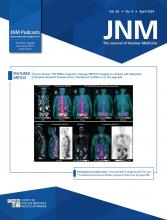Abstract
Aim: 16β-18F-fluoro-5α-dihydrotestosterone (18F-FDHT) is a radiopharmaceutical that has been investigated as a diagnostic agent for the assessment of androgen receptor (AR) density in prostate cancer using positron emission tomography (PET). However, 18F-FDHT is rapidly metabolized in humans and excreted via the kidneys into the urine, which can compromise the detection of tumor lesions close to the bladder. Enzalutamide is an AR signaling inhibitor currently used in different stages of prostate cancer. Enzalutamide and its primary metabolite N-desmethylenzalutamide have a comparable affinity for the AR as FDHT but are both mainly excreted via the hepatic route. Radiolabeled enzalutamide could thus be a suitable candidate PET tracer for AR imaging. Here we describe the radiolabeling of enzalutamide with fluorine-18. Moreover, the in-vitro and in-vivo behavior of 18F-enzalutamide was evaluated and compared to the current standard 18F-FDHT. Methods:18F-enzalutamide was obtained by the fluorination of this nitro precursor. In-vitro cellular uptake studies with 18F-enzalutamide and 18F-FDHT were performed in LNCaP (AR+) and HEK293 (AR-) cells. Competition assays with both tracers were conducted in the LNCaP (AR+) cell line. In-vivo PET imaging, ex-vivo biodistribution, and metabolite studies with 18F-enzalutamide and 18F-FDHT were conducted in athymic nude male mice bearing an LNCaP xenograft in the shoulder. Results: 18F-enzalutamide was obtained in 1.4±0.9% radiochemical yield with an apparent molar activity of 6.2±10.3 GBq/µmol. 18F-FDHT was obtained in 1.5±0.8% yield with a molar activity > 25 GBq/µmol. Co-incubation with an excess of DHT or enzalutamide significantly reduced the cellular uptake of 18F-enzalutamide and 18F-FDHT to about 50% in AR+ LNCaP cells, but not in AR- HEK293 cells. PET and biodistribution studies in male mice bearing a LnCaP xenograft showed about 3 times higher tumor uptake for 18F-enzalutamide than for 18F-FDHT. Sixty minutes after tracer injection, 93% of 18F-enzalutamide in plasma was still intact, compared to only 3% for 18F-FDHT. Conclusion: Despite its lower apparent molar activity, 18F-enzalutamide shows higher tumor uptake and better metabolic stability than 18F-FDHT and thus seems to have more favorable properties for imaging of AR with PET. However, further evaluation in other oncological animal models and patients is still warranted to confirm these results.
- Animal Imaging
- Oncology: Endocrine
- Radiopharmaceuticals
- Androgen receptors
- Enzalutamide
- Mice
- PET imaging
- Prostate cancer
- Copyright © 2021 by the Society of Nuclear Medicine and Molecular Imaging, Inc.







